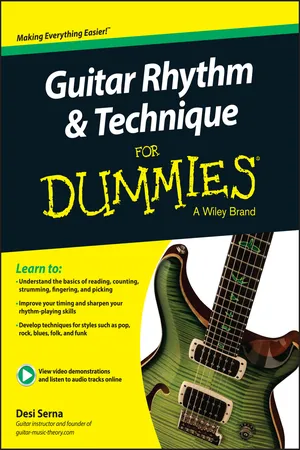
- English
- ePUB (mobile friendly)
- Available on iOS & Android
Guitar Rhythm and Techniques For Dummies
About this book
Improve your guitar-playing rhythm, feel, and timing
If you want to improve your timing, sharpen your technique, or get inspired by new ideas, Guitar Rhythm & Technique For Dummies breaks down the basics of reading, counting, strumming, and picking rhythms on guitar to make you an ace on the axe in no time. With the help of this friendly guide, you'll learn to play examples of eighth and sixteenth note rhythms—including common strum patterns heard in popular music—to improve your guitar rhythm, feel, and timing. Plus, access to audio downloads and online video lessons complement the coverage presented in the book, giving you the option of supplementing your reading with additional visual and audio learning.
There's no denying that guitar is one of the coolest musical instruments on the planet. Okay, perhaps undeniably the coolest. Whether you bow at the feet of Chuck Berry, Keith Richards, the Edge, or Eddie Van Halen, they all have one thing in common: they make it look incredibly, naturally easy! However, anyone who's actually picked up a guitar knows that mastering rhythm and technique is something that takes a lot of practice—not to mention good coaching. Luckily, Guitar Rhythm & Technique For Dummies makes your aspirations to play guitar like the pros attainable with loads of helpful step-by-step instruction on everything from mastering hammer-ons, pull-offs, and slides to perfecting your picking—and beyond.
- Covers strum patterns, articulations, picking techniques, and more
- Showcases musical styles such as pop, rock, blues, folk, and funk
- Includes techniques for playing with both your right and left hand
- Provides access to online audio tracks and video instruction so you can master the concepts and techniques presented in the book
Whether you're new to guitar or an advanced player looking to improve your musical timing and skills, Guitar Rhythm & Technique For Dummies quickly gets you in the groove before the rhythm gets you.
Frequently asked questions
- Essential is ideal for learners and professionals who enjoy exploring a wide range of subjects. Access the Essential Library with 800,000+ trusted titles and best-sellers across business, personal growth, and the humanities. Includes unlimited reading time and Standard Read Aloud voice.
- Complete: Perfect for advanced learners and researchers needing full, unrestricted access. Unlock 1.4M+ books across hundreds of subjects, including academic and specialized titles. The Complete Plan also includes advanced features like Premium Read Aloud and Research Assistant.
Please note we cannot support devices running on iOS 13 and Android 7 or earlier. Learn more about using the app.
Information
Getting Started with Guitar Rhythm and Technique

- Find out how to use a metronome as a pacesetter and to develop rock-solid timing.
- Get to know the most basic parts of the music staff so that you can find your way around a lead sheet.
- Work with note values, rests, and time signatures to play strum patterns and develop your rhythm-guitar skills.
Rhythm and Technique in a Nutshell


www.dummies.com/go/guitarrhythmtechniqueRecognizing the Importance of Rhythm and Technique
Reading and Playing Basic Rhythms
Developing Your Strumming Technique
Honing Your Fretting-Hand Techniques
Honing Your Picking-Hand Techniques
Table of contents
- Cover
- Title Page
- Table of Contents
- Introduction
- Part I: Getting Started with Guitar Rhythm and Technique
- Part II: Reading Rhythms and Strumming Patterns
- Part III: Fretting-Hand Techniques
- Part IV: Picking-Hand Techniques
- Part V: Practice Makes Perfect
- Part VI: The Part of Tens
- Appendix: Audio Tracks and Video Clips
- About the Author
- Cheat Sheet
- Advertisement Page
- Connect with Dummies
- End User License Agreement


